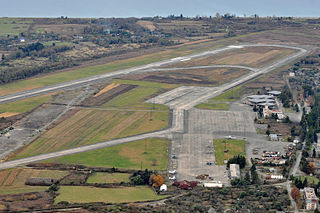Crash
The Tu-134A, tail number СССР-65951, was operating flight 6246 from Tyumen to Volgograd with an intermediate stop in Ufa. At 12:24 (hereafter all times are MSK), flight 6246 took off from Tyumen's Roshchino airport and, after gaining altitude, reached cruising altitude FL350 (10,650 meters). [1]
At 12:45:04, the crew contacted the air traffic controller and reported that they had reached an altitude of 10,650 meters and that the aircraft was following its route. At the same time, at 12:45-12:46, the "FIRE IN THE REAR CARGO COMPARTMENT" alarm sounded in the cockpit. The flight mechanic, taking a smoke protection mask and fire extinguisher, went to inspect the rear cargo compartment and confirmed the presence of a fire. However, he was unable to determine the source of the smoke and extinguish the fire. In fact, the fire had started during the climb, and soon the flames began to destroy the wires, as a result of which at 12:43-12:44 the range channel of the radio technical landing system (RTSM) stopped working. At 12:43:05, the voice recorder MS-61B shut down, and at 12:47:20, due to power loss, the parametric recorders MSRP-64 and KZ-63 also shut down. At that moment, flight 6246 was flying at FL350 on a course of 256° with an indicated airspeed of 490 km/h and was fully controllable. The only deviations were a sharp increase in air pressure differential in the ventilation line and several false commands: "EXCESSIVE BANK," "ENGINE NO. 1 FIRE VALVE CLOSED," "DANGEROUS DESCENT SPEED," and "ENGINE NO. 2 FIRE VALVE CLOSED". [1]
At 12:48:01, the "APU FIRE" alarm activated. At 12:48:57, the pilots contacted the air traffic controller, reported the fire on board, and requested permission for an emergency descent and landing in Sverdlovsk (Koltsovo Airport). In response, at 12:49:09, the controller provided the distance from the airport and azimuth and permitted descent to an altitude of 4,800 meters. At 12:49:37, the airliner began descending on a course of 258°, opposite the landing course (78°). During the process, the crew extended the landing gear. The sky over Sverdlovsk Oblast was overcast at the time, with moderate northeast winds, snow, and visibility of 4-6 kilometers. [1]
At 12:53:56, the crew received instructions to execute a left turn and began doing so while still in the clouds. Due to the cloud cover, the aircraft's marker on the radar screen was unstable, so the air traffic controller only provided bearings. Soon, both single-phase AC converters PO-4500 (powered by 115V) on board the airliner failed, causing the height converter of the transponder (SOM-64) to stop at 12:54:40. At 12:54:52, while performing the left turn, the pilots reported that they were at an altitude of 1,800 meters and that there was a fire in both engines. To reduce thrust and landing speed, thereby shortening the landing roll, the crew shut down engine No. 2 (right) at 12:55:09. Eleven seconds later, at 12:55:20, due to the simultaneous shutdown of two PT-1000C consumers (powered by 36V) and the PT-200C converter, the attitude indicators PP-75 of both pilots and the course system KS-8 "froze." This created a situation where the crew did not know their exact location, and the navigational instruments were failing one by one. Given this, a justified decision was made—an emergency landing off-airport in a field. At 12:55:31, the pilots communicated with the air traffic controller for the last time and set the pressure on the altimeters. The crew then transitioned to visual flight and selected a suitable landing area approximately 1,000 meters long. [1]
At 12:56:40 (14:56:40), 49 kilometers west (azimuth 285°) of Koltsovo Airport, flight 6246, flying on a course of 150° with the landing gear extended and flaps retracted, touched down on a snow-covered field. Digging into the snow, all three landing gear legs began to collapse. After skidding 148 meters through the snow, the airliner lifted off the ground and flew 104 meters before touching down again with both main landing gear legs and the left wing. After 44 meters, it lifted off again. After flying another 180 meters, the airliner touched down for the third time and immediately collided with a stationary irrigation system, which caused the right wing with the right landing gear nacelle to detach. Due to the high speed, the lift of the left wing flipped the aircraft upside down. Sliding "on its back" for several hundred more meters and losing the tail fin and both stabilizers, flight SU-6246 crashed into trees in a forest belt and broke up. The airliner came to a stop 1,028 meters from the initial touchdown point. [1]
At the crash site, 2 crew members and 22 passengers died. Later, 2 more crew members and 1 passenger succumbed to their injuries in hospitals. A total of 27 people died in the crash—4 crew members (the captain, co-pilot, navigator, and flight attendant Motareva) and 23 passengers. [1] Forty-four people survived—2 crew members (the flight mechanic and flight attendant Bobrovskikh) and 42 passengers.















